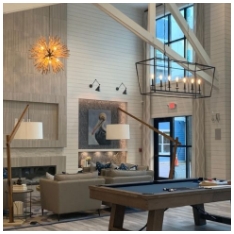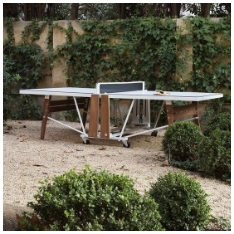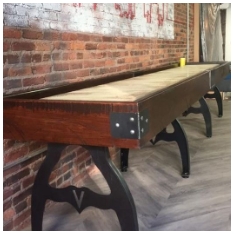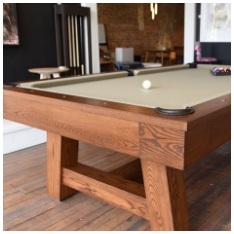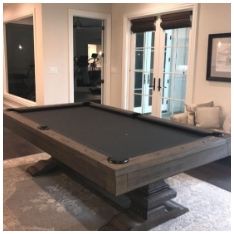Billiards, as a general term, covers several cue sports two of the most popular being snooker and pool. Although they share similarities, the equipment, playing surface, and gameplay differ in important ways. One of the most commonly asked questions by new players and enthusiasts alike What is the difference between a snooker table and a pool table?
This article outlines the key differences between snooker and pool tables, from dimensions and pocket size to cloth type and gameplay rules.
Table Size and Dimensions
Snooker Table Dimensions
A standard full-size snooker table measures 12 feet by 6 feet (3.66 m × 1.83 m). This large surface is necessary to accommodate the 21 colored balls and cue ball used in the game. Due to its size, a snooker table is usually found in professional venues or dedicated game rooms with ample space.
Pool Table Dimensions
Pool tables are smaller by comparison. Standard sizes include 7-foot (bar size), 8-foot (home size), and 9-foot (tournament size) tables. The 9-foot table is the closest to a snooker table in terms of size, but it’s still noticeably shorter and narrower. This makes pool tables more suitable for casual play in homes, recreational centers, and pubs.

Pocket Size and Shape
Snooker Table Pockets
Snooker pockets are narrower and curved, making it more challenging to sink balls. They have a rounded “cut” that requires precise angles and control. This reflects the game’s emphasis on finesse and strategic ball placement.
Pool Table Pockets
In contrast, pool table pockets are wider and more forgiving, designed to accommodate the larger pool balls. Pocket openings have a sharper cut, allowing balls to drop more easily. This design encourages faster gameplay and makes pool more accessible for casual players.
Ball Size and Quantity
Snooker Balls
A standard snooker set includes 22 balls: 15 red balls, 6 colored balls (yellow, green, brown, blue, pink, and black), and one white cue ball. Each ball has a smaller diameter of 52.5 mm (2-1/16 inch), and they are lighter than pool balls.
Pool Balls
Pool uses 16 balls in total: 7 solid-colored balls, 7 striped balls, one black 8-ball, and one cue ball. These balls are larger, typically 57 mm (2-1/4 inch) in diameter and heavier. The size of the balls complements the wider pockets and smaller playing field.
Playing Surface and Cloth
Snooker Table Cloth
Snooker tables use a finer, smoother cloth, often made of worsted wool. The nap (direction of the fibers) affects ball movement, adding a layer of skill for advanced players. It demands careful stroke control and strategic play.
Pool Table Cloth
Pool table cloth is usually faster and more durable, often a blend of wool and nylon. It lacks the directional nap found in snooker cloth, allowing for quicker, more reactive gameplay. This makes pool more dynamic and suited to faster-paced formats.
Game Complexity and Rules
Snooker Gameplay
Snooker is more complex in rules and scoring. Players must pot balls in a specific sequence—alternating between red and colored balls—while keeping track of varying point values. A single frame of snooker can last over 30 minutes, and matches can span several hours. Strategy, defense, and precision play critical roles.
Pool Gameplay
Pool includes several variations such as 8-ball, 9-ball, and straight pool. These formats are generally simpler and quicker than snooker. Scoring is straightforward, with fewer rules about the order in which balls must be potted. Games usually last under 15 minutes, depending on skill level.
Cue Sticks and Equipment
Snooker Cues
Snooker cues are lighter and thinner, with a smaller tip diameter (around 9-10 mm). This design allows for greater control over the lighter, smaller snooker balls and helps players apply subtle spin and cue ball positioning.
Pool Cues
Pool cues are thicker and heavier, with a tip size of 12-13 mm. These cues are built to handle the heavier balls and more powerful shots typical of pool. The design supports faster play and greater shot strength.
Player Skill and Learning Curve
Snooker: Higher Learning Curve
Snooker requires greater precision, patience, and strategic thinking. Learning curve is steeper, especially for players new to cue sports. The table size, smaller pockets, and complex rules make it a more challenging game to master.
Pool: More Accessible
Pool’s simpler rules and smaller tables make it more beginner-friendly. Players can pick up the game quickly and enjoy competitive matches without extensive training or experience. This accessibility contributes to its global popularity.
Venue and Popularity
Snooker Table Availability
Snooker tables, due to their size, are less common in casual settings. They are more often found in dedicated snooker clubs, professional venues, or high-end game rooms.
Pool Table Accessibility
Pool tables are widely available in bars, arcades, recreational clubs, and homes. Their portability and variety of sizes make them easier to accommodate in smaller spaces.
Conclusion
Understanding difference between a snooker table and a pool table helps players make informed choices about which game suits their interest, space, and skill level. While snooker emphasizes strategy and control on a larger table with smaller pockets, pool offers a faster-paced experience with accessible rules and equipment. Whether you're a beginner exploring cue sports or a seasoned player refining your game, knowing these distinctions enhances both appreciation and performance.

